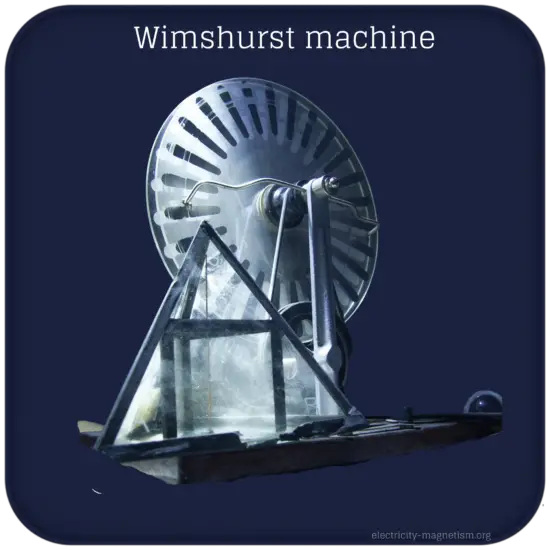30-second summary
Wimshurst machine
Wimshurst machine uses an electrostatic induction effect to create electrical energy. These machines belong to a class of electrostatic generators called influence machines, which separate electric charges through electrostatic induction, or influence, not depending on friction for their operation.

Wimshurst machine
Wimshurst machines use an electrostatic induction effect to create electrical energy. These machines belong to a class of electrostatic generators called influence machines, which separate electric charges through electrostatic induction, or influence, not depending on friction for their operation. It has two dielectric plates with multiple metal blades. A two-ended brush is connected to each plate, and both plates are connected to their own conductor. When the plates are spinning in the opposite direction, the Wimshurst machine starts to collect positive charge on one side of the conductor and negative charge on the other side. It continues until the conductors are enough charged, and voltage will breakthrough between conductors. When the voltage breakthrough occurs, the charging process starts again if the plates are moving.
Static Electricity
Static electricity is an informal term for phenomena caused by the accumulation of electric charge on the surface of various bodies and objects and their exchange in contact with each other.
Most of the static electricity we encounter every day is caused by the triboelectric effect. The triboelectric effect is a type of contact electrification in which certain materials become electrically charged after they come into contact with one another and then separated.
The friction of the two materials greatly increases the effect due to the frequent contact and separation of these materials. On dry days, static electricity is much more noticeable since the air contains fewer water molecules to allow leakage.
Note that a very high voltage is required to generate every 1mm of an electric arc. Air is a very bad conductor of electricity and has high dielectric strength. The dielectric strength of air is nearly 3000V/mm. Under severe conditions, up to 15 000 Volts have been recorded. It is quite common to experience 5 000V. In fact, many people do not feel a shock from a static electricity discharge of less than about 2 000-4 000V. The main reason that shock caused by static electricity does not hurt anybody is its very low amperage.
Frequently asked questions
Most of the static electricity we encounter every day is caused by the triboelectric effect. This can easily be produced by rubbing two dissimilar materials together, such as rubbing amber with fur or glass with silk. The friction of the two dissimilar materials greatly increases the effect due to the frequent contact and separation of these materials.
It is quite common to experience 5 000V. In fact, many people do not feel a shock from a static electricity discharge of less than about 2 000-4 000V. The main reason that shock caused by static electricity does not hurt anybody is its very low amperage.
There are different types of electrostatic generators (ESG’s); they can be friction or induction generators.
Wimshurst machine,
van de Graaff generator,
Rotating-Disc High Voltage Generator.

